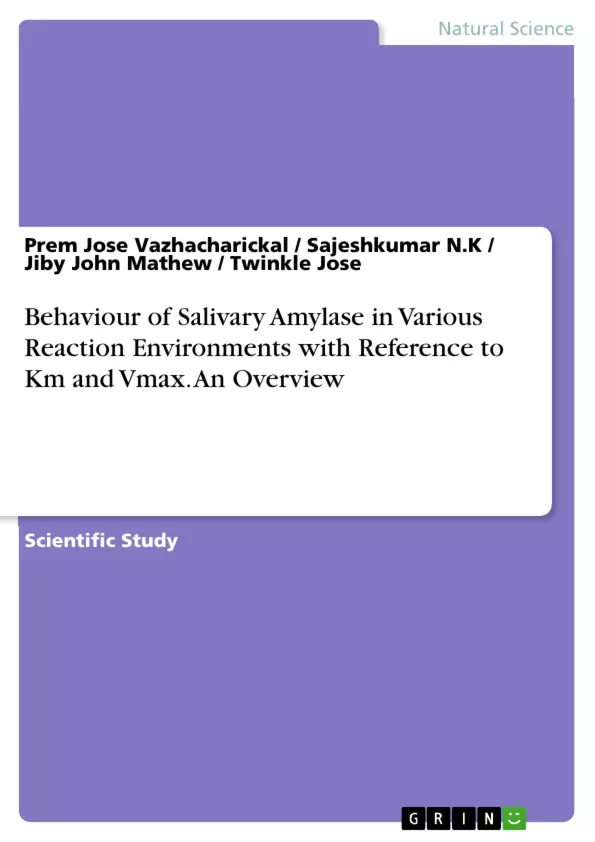Amylase is an enzyme which catalyzes the hydrolysis of α (1, 4)-glycosidic linkages in amylose (a linear form of starch), amylopectin (a branched form of starch) and glycogen into simpler carbohydrate molecules such as oligosaccharides or disaccharides. Alpha-amylase is the major form of amylase found in human, most prominently in pancreatic juice and saliva. The salivary amylase is an amylolytic enzyme, which can acts on cooked or boiled starch and converts it in to maltose. So it became interesting to study the behaviour of salivary amylase, when it is secreted as result of different stimuli. And thus began to study the effect of five different stimulatory temperatures, and also the effect of four tastes on the behaviour of salivary amylase.
For the study of stimulatory effect of temperature on salivary amylase, five different temperatures are selected (4, 27, 37, 55 and 75°C). And likewise four tastes also selected (sweet, sour, salt and bitter). The DNS method was done in the both tests to obtain the absorbance at 520 nm. The samples were collected from three people, of same age. The saliva was collected at same time, after one and a half hour of their breakfast in order to maintain a controlled condition for this study. In each cases the incubation temperature also kept as variable (4, 27, 37, 55 and 75°C). This study was also aimed to determine the behaviour of salivary amylase with reference to the kinetic parameters like Km and Vmax of salivary alpha amylase by incubating the enzyme (stimulated by different stimulatory conditions of temperature and taste) with varying concentration of substrate. The study revealed the consistency in kinetic parameters like Km and Vmax of salivary alpha amylase secreted in response to various stimuli.
Inhaltsverzeichnis (Table of Contents)
- Behaviour of salivary amylase in various reaction environments with reference to Km and Vmax: an overview
- Abstract
- Introduction
- Industrial use of alpha amylase
- Clinical chemistry and importance
- Objectives
- Review of literature
- Salivary alpha amylase
- Alpha amylase assay
- Hypothesis
- Materials and Methods
- Study area
- Sample collection
- Reagents
- Assay procedure
- Statistical analysis
- Results and discussion
- Conclusions
- Acknowledgements
- References
Zielsetzung und Themenschwerpunkte (Objectives and Key Themes)
This research aims to investigate the behaviour of salivary amylase in various reaction environments, specifically focusing on its kinetic parameters, Km and Vmax. The study aims to understand how different conditions, such as temperature, pH, and substrate concentration, affect the enzyme's activity.
- Activity of salivary amylase in different reaction environments
- Determination of Km and Vmax of salivary amylase
- Impact of temperature and pH on amylase activity
- Exploration of the industrial and clinical significance of salivary amylase
- Analysis of the factors influencing salivary amylase activity
Zusammenfassung der Kapitel (Chapter Summaries)
The research begins with an introduction that outlines the industrial and clinical relevance of alpha amylase. It then reviews existing literature on salivary alpha amylase and the methods for its assay. The study details the materials and methods used for collecting samples, conducting experiments, and analyzing the data. This includes a description of the study area, the sample collection process, the reagents used, and the statistical analysis methods employed. The research concludes with a discussion of the results and their implications.
Schlüsselwörter (Keywords)
The key focus of the research is on salivary amylase, its kinetic parameters (Km and Vmax), and the factors influencing its activity. The study explores the enzyme's behaviour in different reaction environments, specifically examining the effects of temperature, pH, and substrate concentration. The research also highlights the industrial and clinical significance of salivary amylase.
- Arbeit zitieren
- Dr. Prem Jose Vazhacharickal (Autor:in), Sajeshkumar N.K (Autor:in), Jiby John Mathew (Autor:in), Twinkle Jose (Autor:in), 2016, Behaviour of Salivary Amylase in Various Reaction Environments with Reference to Km and Vmax. An Overview, München, GRIN Verlag, https://www.grin.com/document/367145



